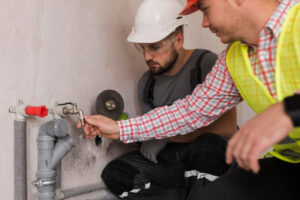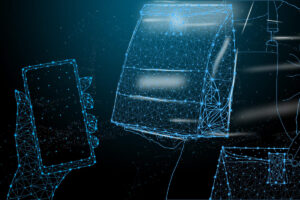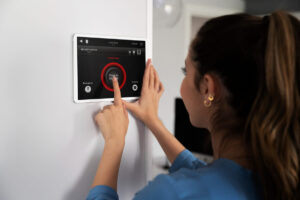AI-powered robotics in construction refers to the integration of artificial intelligence algorithms with robotic systems to automate and improve building fabrication tasks. In digital fabrication – which includes processes like robotic 3D printing, automated assembly, and CNC machining – AI serves as the “brains” that allow robots to learn, sense, and make decisions.
These intelligent machines can adjust to variability in real time, optimizing how construction materials are placed and handled. By leveraging machine learning and sensor data, AI-powered robots achieve greater precision and autonomy than traditional automation, leading to safer and more efficient construction workflows. From construction sites to prefab factories, AI is now helping robots build complex structures with minimal human intervention, redefining what’s possible in terms of speed, quality, and customization.
Table of Contents
Way 1: Adaptive On-Site 3D Printing with Real-Time Decision-Making
One major advancement is AI-driven 3D printing on construction sites. In traditional 3D concrete printing, a robotic printer follows a pre-set path and settings. AI improves this by enabling real-time sensing and decision-making during the print. For example, machine learning algorithms optimize the printer’s extrusion path on the fly based on sensor feedback. If conditions change – say the ground shifts slightly or the concrete flow varies – the AI can immediately tweak parameters like nozzle speed, extrusion rate, or layer height to maintain print quality. This adaptive path planning ensures each layer is deposited with consistent thickness and alignment, reducing voids and weak spots in the structure.
An example scenario is a large-scale concrete printer constructing a wall directly on site. As wind or temperature fluctuates, AI vision systems inspect each new layer for any warping or misplacement. If a section starts to deviate, the AI controller pauses or adjusts the robot’s trajectory to compensate, rather than waiting for a human to intervene. In one case, researchers demonstrated a 3D printer with a camera and depth sensor that measured layer shape and automatically corrected the deposition in real time. Similarly, industry solutions are emerging where AI monitors layer adhesion and makes instant corrections – ensuring the printed structure remains sound from the ground up.
Beyond the print nozzle, AI also helps integrate site data for printing. Using drone scans and Building Information Modeling (BIM), an AI system can map the construction site and determine the optimal printer placement and path to avoid obstacles. It accounts for terrain, nearby materials, and even crane locations so that on-site 3D printing proceeds smoothly. This level of real-time adaptability and planning was not possible with earlier rigid automation. AI-powered robotics thus turns on-site 3D printing into a flexible process – the robot not only follows instructions but also “thinks” and responds to ensure quality. The result is more robust printed structures and fewer delays due to environmental uncertainties.

Way 2: Smart Robotic Assembly of Prefabricated Components
Another area being transformed is the robotic assembly of prefabricated components. Prefabrication means building parts of structures (like panels, modules, or beams) in a controlled environment before assembly. AI empowers construction robots to precisely recognize, sort, and assemble these components with minimal human guidance. Using computer vision, an AI-powered robot can identify a part’s shape and orientation, then determine how to grasp and position it correctly. This capability is critical when assembling complex modules where each piece must align perfectly.
For instance, in modular home construction, factories now deploy robotic arms to build wall panels and roof trusses. Guided by AI vision, the robot can pick up lumber or panels, orient them accurately, and fasten them together to exact specifications. Continuous quality checks are performed by the robot’s AI as well – cameras inspect holes, joints, or nail positions, and the AI halts or adjusts the process if something is off by even a few millimeters. This ensures each prefabricated panel meets design tolerances before it ever leaves the factory floor.
A real-world example is the use of an AI-enabled robotic micro-factory for timber construction. A startup in London developed a mobile factory where a robot (built by ABB) constructs wooden wall panels autonomously. The robot cuts pieces to size, then uses AI-guided positioning to nail them into panels. As it works, the AI vision system verifies every connection, catching misaligned studs or gaps that humans might miss.
Once the panel is complete, it’s transferred to the site for assembly into the building’s structure. The AI allows mass customization too – without reprogramming, the same robotic cell can switch between different panel designs or dimensions on the fly. This flexibility means each module can be tailored to an architect’s plan, yet still assembled with factory precision.
On the construction site, AI-powered robots assist in placing and securing modules as well. Consider an autonomous crane or robotic positioning system that uses AI to orient a precast concrete block and set it into place. By analyzing sensor data and markers on the module, the AI can guide the crane’s movements to achieve millimeter-level accuracy, far exceeding a purely manual operation.
One notable example is an autonomous rebar-tying robot used in bridge construction: it employs cameras and AI to locate every rebar intersection and tie it with consistent quality. This robot (called TyBot) replaces a laborious manual task by “seeing” the grid of steel bars and methodically securing each joint. Such examples show how AI-powered robotics can handle assembly tasks – from heavy modular components to dense rebar networks – with greater speed and safety. Robots don’t get tired or careless, and their AI ensures each piece is assembled exactly as intended, which improves overall construction reliability.
Suggested article to read: The Role of 3D Printing Robots in Construction; 2025 Guide
Way 3: AI-Guided Quality Control and Defect Detection
AI-powered robotics are also enhancing quality control (QC) in digital fabrication by detecting defects that human inspectors might overlook. Construction fabrication often involves critical tolerances – a small crack in a 3D-printed wall or a slight misalignment in formwork can lead to structural issues. AI systems excel at analyzing images and sensor data to find these tiny anomalies.
High-resolution machine vision, paired with deep learning models, can scan surfaces or components for any sign of defect: for example, hairline cracks, air pockets, uneven surfaces, or mis-positioned parts. The AI learns the visual patterns of “normal” quality versus defects from vast training data, enabling it to flag even subtle deviations. In fact, modern AI vision can flag microscopic flaws that human inspectors could miss, achieving up to 98–99% defect detection accuracy in some manufacturing settings.
In digital fabrication for construction, this means a robotic inspection unit can continuously monitor the output. For instance, as a concrete 3D printer lays down layers, an AI-driven camera system watches each layer for irregular thickness or poor adhesion between layers. If the AI detects a potential weak spot (maybe a void or a layer slightly out of shape), it can alert operators or even adjust the process (as described in Way 1) to fix it immediately. This real-time visual feedback loop ensures quality is built into the product, not just checked at the end.
AI-guided QC is equally valuable for inspecting prefabricated elements and formwork. Consider precast concrete panels made in a factory – an AI vision system can inspect each panel’s surface for fine cracks or honeycombing that would be hard to catch with the naked eye. It can also compare the finished piece against the digital design (BIM model) to verify all dimensions and openings are correct.
Importantly, AI doesn’t get fatigued or rushed; it will inspect every millimeter of a component if needed. In one case, an AI inspection platform on a construction site used 360° cameras to compare as-built conditions with the plan, automatically highlighting dozens of discrepancies that site staff had missed. Detected issues ranged from misaligned wall installations to missing embeds, which were then corrected before they became costly problems. This kind of automated defect detection not only improves quality but also safety (by catching structural errors) and reduces rework.
By integrating AI into quality control, construction teams benefit from an objective “second set of eyes” that is always on duty. Defects that might slip through a hurried manual inspection are promptly caught by the AI, and often earlier in the process. This leads to higher overall build quality and confidence in digitally fabricated components. It also frees human inspectors to focus on evaluating more complex issues, while routine scanning is handled by robots. Overall, AI-powered visual inspection raises the bar for construction quality assurance, ensuring that modern fabricated elements meet strict standards before they’re assembled on site.
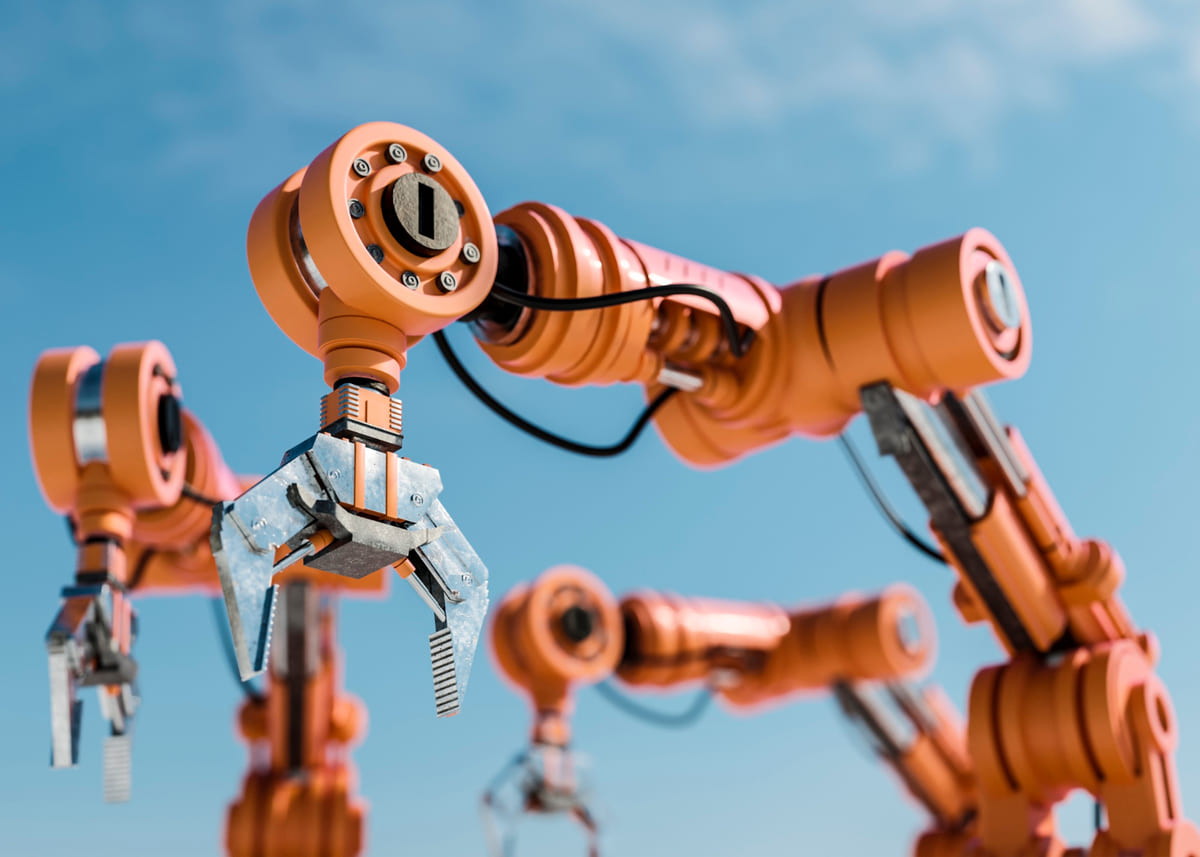
Way 4: Autonomous Heavy Machinery Coordination on Construction Sites
On large construction sites, coordinating heavy machinery like bulldozers, excavators, and haul trucks is a complex dance. AI-powered robotics is now tackling this by enabling fleets of earthmoving machines to work autonomously in unison. Instead of each piece of equipment being operated in isolation, a central AI “brain” can optimize the movements of all machines to maximize efficiency and safety.
For example, an AI fleet management system can direct multiple autonomous dump trucks to queue at an excavator, have one truck move in as soon as another is filled, and route them along the safest, fastest path to a dump site. The AI continuously monitors each vehicle’s status (location, load, fuel level) and orchestrates their tasks so there’s minimal idle time or congestion.
This multi-machine coordination has been demonstrated in large earthmoving operations. One system, known as the “Haulage AI,” manages a network of self-driving haul trucks and bulldozers on a site. It assigns work to each dozer or truck, adjusts the speed to maintain proper spacing, and even handles traffic control at intersections. As each vehicle completes a task, it immediately receives the next command from the AI dispatcher, creating a seamless loop of excavation and hauling.
Human supervisors simply oversee the process from a control center rather than sitting in each machine. The improvement in productivity is significant – these robots can operate 24/7, without breaks, and make precise movements based on sensor data and digital terrain maps. Automated bulldozers, for instance, can grade a surface to within a very tight tolerance using GPS and onboard LiDAR, achieving a level finish faster than a human operator could.
Safety is a major benefit of AI-coordinated heavy machinery. With no crew required on or around the equipment, the risk of injury from vehicle collisions or rollovers is greatly reduced. The AI also enforces safety zones: it will slow or stop machines if an unexpected obstacle (like a person or another vehicle) is detected in the area. In practice, companies have found that removing operators from cabs and placing them in remote operation rooms improves safety and job satisfaction.
For example, a single operator can monitor several autonomous dozers via cameras, intervening only if the AI flags an anomaly. Meanwhile, the AI keeps the machines working at optimal output and adheres to designated safe paths. There are already autonomous dump trucks in mines and large construction projects that have driven millions of hours with a strong safety record, thanks to AI route planning and obstacle detection.
Precision is another advantage. AI guidance enables heavy machines to perform repetitive tasks, like trench digging or soil compaction, with consistent accuracy. If multiple excavators are digging footings on a site, the AI can ensure each hole is to exact depth and position, coordinating their work so they don’t interfere with each other. This level of coordination reduces errors and rework. In summary, AI-powered robotics is turning heavy equipment into a collaborative, self-driven team. Projects see faster completion times (machines don’t wait on each other or make ad-hoc decisions) and safer operations, all while maintaining high precision in earthmoving and material handling tasks.
Way 5: Predictive Maintenance of Fabrication Equipment
AI isn’t just improving how things are built – it’s also changing how we maintain the robots and machines that do the building. Predictive maintenance uses AI algorithms to analyze sensor data from equipment and predict when maintenance or repairs are needed, before a breakdown occurs. In digital fabrication, downtime of a 3D printer or robotic arm can halt production. AI helps avoid unplanned outages by continuously monitoring the “health” of these machines. Sensors on a robotic fabrication line might collect data on motor currents, vibration levels, temperatures, and oil quality. The AI models learn the normal operating patterns and can detect subtle signs of wear or stress that precede a failure.
For example, if a concrete printer’s pump motor begins to draw slightly more power and vibrate in an unusual way, the AI maintenance system flags it as an early warning. It might predict that a pump seal is wearing out, and maintenance should be scheduled within the next 10 print hours. This allows technicians to fix or replace the part during planned downtime, instead of the pump failing unexpectedly in the middle of a print. AI can forecast issues like this with impressive accuracy. In one instance, an AI predicted a critical robot gear would fail weeks in advance by recognizing an anomaly in the vibration frequency data – something a human monitoring occasional readings might not catch.
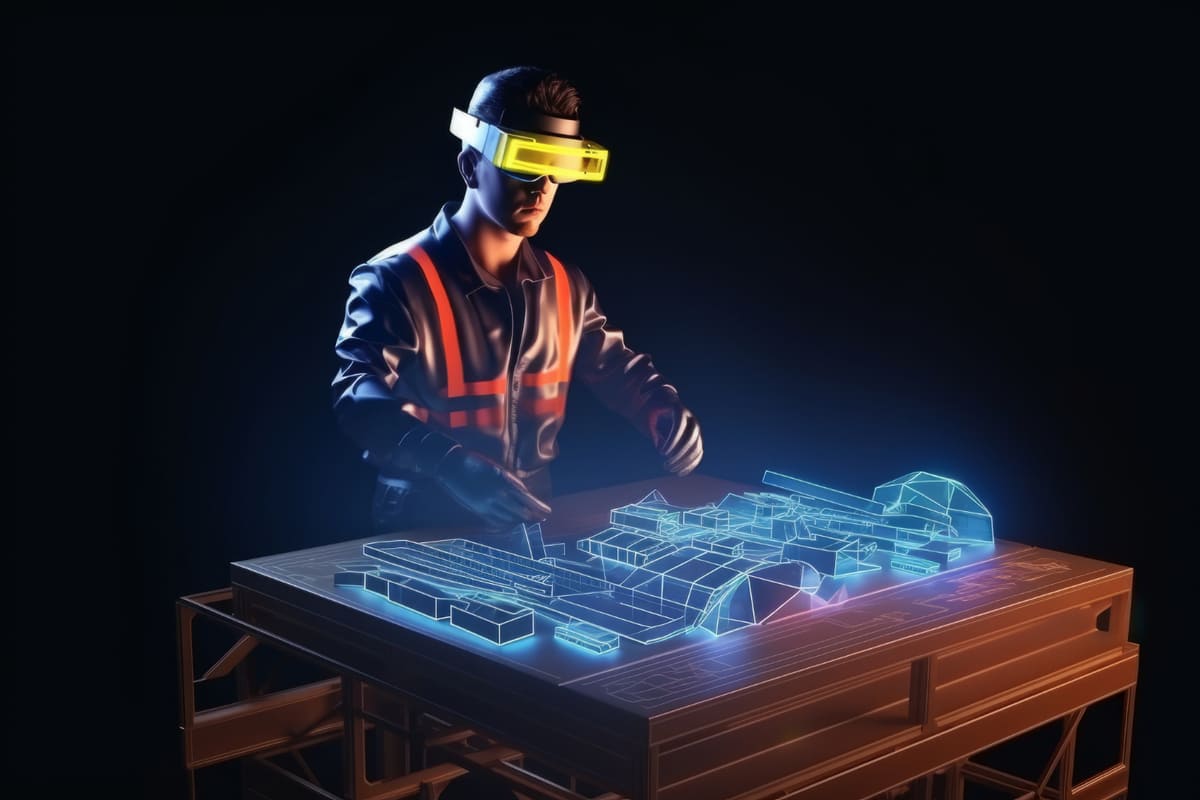
Predictive maintenance driven by AI has been adopted in advanced construction factories and by heavy equipment fleets. The approach generally leads to a significant reduction in downtime. By servicing machines only when needed (and just before failure), companies avoid both the scenario of reactive repairs after a breakdown and the inefficiency of replacing parts too early on a fixed schedule.
In the context of AI-powered robotics, this means the expensive robotic fabricators and site robots are kept running smoothly for longer. AI might schedule a brief daily check or calibration for a 3D printer if sensors show minor deviations, thereby preventing cumulative damage. It will also prioritize maintenance tasks: for example, alert that the robotic arm used for cutting panels has a 85% probability of needing a new bearing in the next 10 cycles, which can then be addressed in the next shift change.
The result is extended equipment life and more reliable fabrication processes. Construction robots and printers face variable loads and conditions, so an AI maintenance system helps adapt the care of the machine to its actual usage patterns. Many modern systems already incorporate this: one report noted that AI-based models can identify patterns in machine sensor data that indicate imminent failure, allowing proactive fixes that avoid sudden breakdowns.
Over time, these AI systems also learn from maintenance records – improving their predictions (for instance, correlating a certain temperature spike with impending hydraulic issues). By minimizing unplanned downtime, projects can stick to tighter schedules, and expensive machinery gets the maintenance it truly needs rather than on a generic timetable. For construction firms, this translates to cost savings and higher productivity, as their AI-powered robots spend more time building and less time in repair.
FAQs
How are AI-Powered Robotics used in construction digital fabrication?
AI-powered robotics are used in construction to automate and enhance fabrication tasks like 3D printing, component assembly, and site operations. In digital fabrication, robots equipped with AI can interpret design data and execute construction tasks autonomously. For example, AI-powered robotic arms can lay bricks or print concrete by following a building’s digital model, adjusting in real time if conditions change.
They are also used in factories to assemble modular building sections with precision. The AI algorithms process sensor inputs (cameras, lasers, etc.) to guide the robot’s movements, ensuring each action (placing a panel, welding a joint, tying rebar) is performed correctly. Essentially, AI-powered robotics take on repetitive or technically complex tasks – like creating free-form concrete shapes with a 3D printer or sorting and installing thousands of facade panels – much faster and more accurately than manual labor. This frees human workers to focus on supervising and optimizing the overall process. The result is that digital fabrication in construction becomes more efficient and consistent, with robots reliably carrying out the heavy work under AI guidance.
What benefits do AI-Powered Robotics bring to construction processes?
AI-powered robotics bring several key benefits to construction. Efficiency is greatly increased – robots can work around the clock without fatigue, and AI optimizes their actions to reduce wasted time and materials. This can shorten project timelines and lower costs. Precision and quality improve as well, because AI systems guide robots to perform tasks with high accuracy (for instance, cutting components to exact dimensions or detecting and correcting mistakes in real time). Another benefit is enhanced safety. Robots can handle dangerous jobs such as working at great heights, handling heavy loads, or operating in hazardous environments, thereby reducing the risk to human workers.
AI monitoring also makes the worksite safer by predicting and preventing potential accidents (e.g. flagging structural issues or ensuring equipment operates within safe parameters). Additionally, AI-powered robots provide greater consistency – the output is uniform, which improves the reliability of the construction. They also enable new design possibilities: complex designs that are difficult for manual labor (like organic shapes or intricate assemblies) can be executed by robots programmed with AI, expanding what architects and builders can create. Overall, integrating AI-powered robotics leads to faster construction, better quality buildings, a safer work environment, and often more sustainable use of resources.
Which construction tasks benefit most from AI-Powered Robotics?
Tasks that are repetitive, precision-dependent, or high-risk benefit greatly from AI-powered robotics in construction. For example, bricklaying and masonry work can be done by robotic systems (like bricklaying robots) that precisely place each brick and apply mortar consistently – tasks that benefit from robotic repeatability. 3D concrete printing is another, where AI robots fabricate entire walls or structures layer by layer, which excels in producing complex shapes with minimal waste.
Assembly of modular components in factories is highly suited to robotics: installing hundreds of bolts or welding many joints is faster and more accurate with robot arms, and AI ensures each connection meets specifications. Inspection and quality control tasks also benefit – AI-powered drones or robots can scan vast construction areas or components to detect defects, something that would be time-consuming or prone to error for humans.
Additionally, earthmoving and site grading see improvements, as autonomous bulldozers and excavators can perform digging, grading, and material transport continuously under AI coordination (improving speed and precision of earthwork). High-risk tasks like working in hazardous environments (e.g., disaster site cleanup, nuclear decommissioning) are better handled by robots to keep humans out of harm’s way. In summary, any construction task that requires a combination of consistency, accuracy, around-the-clock work, or hazard mitigation is a strong candidate for AI-powered robotic assistance.
Is it true that AI-Powered Robotics will replace human workers in construction?
It is not so simple. AI-powered robotics are set to change construction work, but not outright replace humans across the board. These technologies excel at automating specific tasks – especially repetitive, strenuous, or highly precise jobs – and in those areas, robots will reduce the need for manual labor. For instance, a robot may take over the job of tying rebar on a bridge or continuously printing a concrete wall, roles that traditionally might employ several laborers.
However, construction projects are very complex and dynamic, and they still require human expertise for many aspects. Humans are needed to plan, supervise, and handle complex decision-making that robots are not capable of. Skilled tradespeople will still install systems and do finishing work that requires adaptability and craft. What is happening is a shift in roles: instead of performing repetitive tasks, human workers may move into roles as robot supervisors, maintenance technicians, or focus on tasks that require problem-solving and creativity.
Early evidence suggests that rather than massive job loss, AI and robotics can help fill the labor gap in construction (addressing skilled labor shortages) and allow human workers to be more productive. A McKinsey study noted that automation in construction is likely to increase productivity without necessarily cutting jobs, as the industry has room to grow and can reallocate labor to new tasks. In summary, AI-powered robotics will change the nature of construction jobs – making many tasks safer and less labor-intensive – but human workers will remain essential for the foreseeable future, working alongside robots to deliver projects more efficiently.
Conclusion
Across the construction industry, AI-powered robotics is redefining efficiency, safety, and customization in digital fabrication. In on-site 3D printing, AI enables robots to adapt to real-time conditions, ensuring that printed structures are structurally sound and accurately formed without constant human oversight. In modular construction and assembly, robots guided by AI can handle complex prefabricated components – recognizing parts, fitting them precisely, and even adjusting to design variations – which speeds up building assembly while maintaining quality.
AI-driven vision systems are taking quality control to new heights by catching defects and mistakes that human inspectors might miss, thus preventing costly rework and enhancing the safety of the final structure. On dynamic construction sites, autonomous bulldozers and trucks now work in coordinated harmony, with AI optimizing their routes and tasks to complete heavy work faster and with fewer accidents. And behind the scenes, AI-based predictive maintenance keeps the whole fleet of machines and robots running smoothly, reducing downtime and extending equipment lifespan.
Together, these five applications illustrate a broader trend: construction is moving from manual, labor-intensive methods toward smart, data-driven fabrication processes. AI-powered robots can execute repetitive or precision tasks consistently and can also learn and improve over time. This not only boosts productivity and lowers waste, but also allows human workers to focus on higher-level supervision, creative problem-solving, and tasks that truly require human expertise. We are also seeing greater possibilities for customization in construction – AI makes it feasible to fabricate unique designs or adapt on the fly without sacrificing efficiency, meaning architects and engineers have more freedom to innovate.
Crucially, the integration of AI addresses some long-standing challenges in construction such as low productivity growth and on-site hazards. Early projects and case studies have shown productivity improvements (e.g. faster project delivery and fewer errors) by adopting these technologies. Safety incidents can be reduced when robots handle dangerous tasks like heavy lifting, working at heights, or repetitive strain activities.
While there are still hurdles – such as training workers to collaborate with robots and ensuring AI decisions are transparent and reliable – the trajectory is clear. AI-powered robotics in digital fabrication is pushing the construction industry toward a future of smarter workflows, where buildings are constructed more quickly, safely, and tailored to exact needs. This synergy of AI and robotics is set to transform construction in the coming years, much as automation revolutionized manufacturing decades ago, ushering in a new era of efficient and high-quality construction practices.
Resources:
-
McKinsey & Company. (2019). The impact and opportunities of automation in construction.
-
Yenra. (2023). 20 Ways AI is Advancing 3D Construction Printing Optimization.
-
3D Adept Media. Chandar, A. (2025). The use of AI and 3D Printing in construction.
-
Keymakr. Abramov, M. (2024). Seeing the Unseen: Data Annotation for AI-powered Defect Detection in Construction.
For all the pictures: Freepik
Suggested article for reading:
4 Types of Fire Detection Systems and Where to Use Each One in 2025
Top 7 Sustainable Digital Fabrication Innovations Leading the Green Revolution
5 Tips on Choosing a Construction Company for Residential and Commercial Projects
8 Key Features of Next-Gen Fire Detection Systems
10 Digital Fabrication Trends Shaping the Future of Smart Manufacturing


